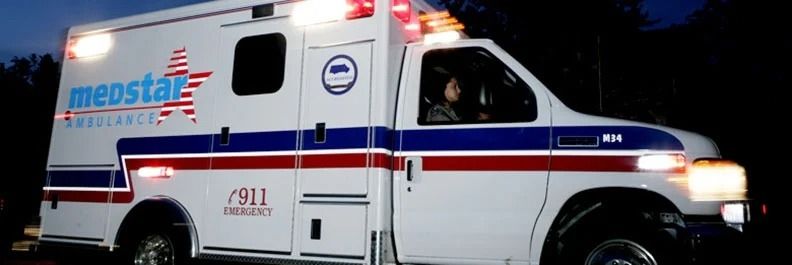 Getty Images
Getty Images
Heart attack patients rushed to War Memorial Hospital in Sault Ste. Marie, Michigan are quickly stabilized and prepared for transfer to a hospital with a heart catheterization lab. The Upper Peninsula hospital, like most in rural Michigan, is not equipped to handle interventional cardiac or neurological care.
But right now War Memorial is short-staffed — only 36 of its 49 licensed beds are open because of staffing — and it’s near capacity with 33 patients filling beds last week. Patient transfers are more critical now than ever.
Yet the ambulances aren’t coming.
Nursing managers are calling upwards of 20 ambulance services before a truck can be scheduled. Even then, the wait times are long, usually 24 hours or more.
 War Memorial Hospital David Jahn, CEO of War Memorial Hospital.
War Memorial Hospital David Jahn, CEO of War Memorial Hospital.
“It delays the specialty care that they need, since we can’t provide that level of care here at the local hospital,” War Memorial CEO David Jahn said. “This could have complications and potentially could lead to death. The sooner you can get a patient in to a cath lab the better and once they diagnose the level of blockage they can immediately put a stent in or bring the patient in for open heart surgery.”
Jahn said War Memorial can receive an emergency helicopter more quickly than an ambulance — but insurance companies won’t pay for that unless a patient is in immediate danger of dying without it.
There’s a shortage of available ambulances across the state for these types of transfers, and it’s leading to dangerous situations in rural Michigan’s healthcare industry. The shortage is driven partly by the ongoing labor shortage, but the full picture is more complicated, exacerbated by a patchwork of rules to protect territories for local ambulance services, as well as demand for paramedic skills outside of the flashing red lights of an emergency vehicle.
“It’s getting really bad in rural areas of the state,” said Jahn. “We’re seeing more and more patients and many need to be transferred. But if you come to the ER and need to be transferred, we can’t guarantee that is going to happen because we don’t know if an ambulance will be available. Our doctors are having to tell patients’ families we don’t have the ability to treat their loved one here, but we also can’t get them an ambulance to take them where they could get appropriate care.”
Paramedic paucity
War Memorial Hospital relies on Kinross EMS, located southwest in Chippewa County, and Sault Ste. Marie’s fire department, staffed with firefighters who are also licensed paramedics.
However, the fire department is also short-staffed. There are 14 firefighter paramedics in the squadron with four open positions, leaving the department stretched thin to handle 911 calls and War Memorial’s patient transfer needs.
“We have a transfer program, but our primary mission is to serve our community,” said Brian Chapman, city manager for Sault Ste. Marie. “We are obviously concerned about the quality of health in our community, but it’s just a numbers game. When we have our own local 911 calls that are happening at a regular pace, when we get transfer requests, we have to turn them down. We’re at this crossroads where we have to make real-time decisions whether we’ve got the manpower to facilitate transfers.”
There are roughly 1,000 open paramedic and emergency medical technician positions in Michigan, according to the Michigan Association of Ambulance Services.
Ambulance services are pushing more and more overtime on workers to stay on top of emergency demand, said Angela Madden, executive director of the advocacy group.
“A typical work week is 36 to 56 hours, but in reality most EMTs and paramedics are working 60 to 80 hours per week,” Madden said. “Morale is low, and we’re losing more and more people at a time where fewer people are coming into the field.”
Madden said ambulance services typically attract adrenaline junkies, sometimes former soldiers, excited by the idea of saving lives, but the job is often more monotonous.
“It’s not all interfacing with an emergency helicopter and flipped-over cars on the freeway; much of the work is the patient transfer piece or moving patients between facilities in the same town,” Madden said. “It’s not sexy and it’s not exciting. A lot of people realized they can go to school for two years (the same length of time it takes to get a paramedic license) and become a nurse and work in a private setting in a hospital and make more money than working in a 5-foot-by-8-foot box sitting on the side of the road.”
 Michigan Association of Ambulance Services Angela Madden, executive director of Michigan Association of Ambulance Services.
Michigan Association of Ambulance Services Angela Madden, executive director of Michigan Association of Ambulance Services.
Hospitals regularly recruit paramedics as emergency room technicians because they are licensed to intubate patients — a common procedure for severe COVID-19 patients — which is a higher skill level than some nursing categories, Madden said. That recruiting has been increased by the pandemic as hospitals have faced severe worker shortages as well. This hiring was originally spurred by the Affordable Care Act, which provided funding to emergency departments to hire paramedics, Madden said.
“We have 29,000 licensed EMTs and paramedics in the state, but many of them are not practicing in an ambulance,” Madden said. “We have lots of paramedics in ERs and in security teams at large corporations now, which means fewer people are working the road to transfer patients or respond to a 911 call on any given day.”
Jahn said War Memorial has tried to hire paramedics in its emergency department but has largely been unsuccessful.
Sault Ste. Marie’s fire department relies heavily on the EMT and paramedic certification program at hometown Lake Superior State University to supply its workers, but the program was halted for several months during the pandemic, Chapman said.
Chapman said the community has faced tough recruiting efforts due to its rural location.
“We’re facing staffing shortages in all of our departments,” he said. “We have a hard time recruiting any open position, whether it’s a streets employee at the department of public workers or a firefighter paramedic. Fact is people don’t want to get into local government. Especially when people can find easier jobs for more pay in the private sector.”
COVID-19 has complicated matters further for the Sault Ste. Marie fire department. Chapman said due to the prevalence of the coronavirus in nursing homes, its ambulances have been busy transferring patients across the Upper Peninsula to hospitals like War Memorial.
And making matters even worse at the moment: Two of its 14 firefighter paramedics are currently off duty after testing positive for COVID.
Protectionist problems
Clinton Township-based Medstar, the largest ambulance service in the state with 945 employees and 155 trucks, has trained 103 new EMTs this year with another 30 in its current academy cohort.
 Medstar Ambulance Rules limit where some of Michigan’s largest ambulance companies, such as MedStar, can help with patient transfers.
Medstar Ambulance Rules limit where some of Michigan’s largest ambulance companies, such as MedStar, can help with patient transfers.
The provider, a nonprofit jointly owned by Ascension Health, Henry Ford Health System and McLaren, provides 911 service to nine counties in Southeast Michigan but is increasingly performing patient transfers all over the state.
But its scope is limited by protectionist rules established by medical control authorities, which oversee local emergency response services. Those authorities, directed by a board of hospital and EMS administrators, license which EMS service can operate in a given geography. Those rules are designed to ensure citizens have access to emergency transportation at all times. They are also part of the problem with the bottleneck in patient transfers.
Ambulance services can transfer patients only to or from a community in which they are licensed. Those licensed service providers are also usually required to maintain dedicated ambulances in a given community around the clock for 911 calls, said Kolby Miller, CEO of Medstar.
 Medstar EMS Kolby Miller, CEO of Medstar EMS.
Medstar EMS Kolby Miller, CEO of Medstar EMS.
Rural communities may not need another truck for 911 service, or the demand doesn’t make it worth it for a company like Medstar, but the transfer demand is there.
“We get called not infrequently to go a long way away, sometimes north of the bridge,” Miller said. “The local provider isn’t available or won’t do it, so we’re asked. But the medical control authority is going to ask me if am going to be providing 911 service. If they approve me for one truck, then I have an obligation for the 911 calls and can’t leave for any long-distance transfers. Some of the system’s design is set up by the providers in the system to protect the market they want to protect. So unless I can be present all the time, I can’t service those transfers. This is a structural problem, not a staffing problem.”
For instance, Medstar isn’t licensed in Grand Rapids or Saginaw, so therefore cannot perform a patient transfer between those two communities even if it has capacity and the need exists.
Last year, War Memorial was unable to secure enough patient transports and petitioned the Michigan Bureau of Emergency Medical Services to allow for a downstate ambulance service to perform transfers.
The state authorized one Medstar ambulance to provide transfer service from War Memorial for a few weeks.
But other systems aren’t as lucky and are resorting to drastic measures, Jahn and Madden said. Some nursing managers when unable to secure a patient transfer are calling 911 and telling the EMS that a patient is in their waiting room and needs a transfer. EMS companies are legally required to respond to all 911 calls.
 War Memorial Hospital in Sault Ste. Marie.
War Memorial Hospital in Sault Ste. Marie.
War Memorial has not resorted to this tactic … yet.
“(The Bureau of EMS) told us legally, if we don’t get a response from our local EMS agencies that we should call 911 because the EMS agencies are required by law to respond to a 911 call,” Jahn said. “We have not resorted to that yet here at WMH, but we were told that we could do this. Because we need to keep good relationships with all of our local EMS agencies, since there are so few ambulance services in our area, we don’t want to use this tactic as it would only drive more of a wedge between the hospital and the EMS agencies.”
Jahn hopes the state is able to revise rules for ambulance service in a statewide emergency like the pandemic. Madden wants EMS to become an essential service — currently ambulance services are paid for by insurance companies and users, not taxes.
“EMS is still considered suppliers of transportation and not providers of healthcare,” Madden said.
None of that is likely to happen soon to alleviate the troubles of War Memorial or other rural hospitals during the pandemic.
“This problem has many folds in rural Michigan, and I just don’t know how we’re going to meet demand and make this work,” Jahn said.
Related Articles  Six things to know about prior authorization for ambulances
Six things to know about prior authorization for ambulances  Rural ambulance services are in jeopardy as volunteers age and expenses mount
Rural ambulance services are in jeopardy as volunteers age and expenses mount  CMS: Prior authorization slashed ambulance transportation by 70%
CMS: Prior authorization slashed ambulance transportation by 70%  Ambulance companies rethink business plan as volumes, revenue decline
Ambulance companies rethink business plan as volumes, revenue decline  In ambulances, an unseen, unwelcome passenger: COVID-19
In ambulances, an unseen, unwelcome passenger: COVID-19
Source link : https://www.modernhealthcare.com/labor/demand-emts-territorial-rules-make-patients-sit-and-wait











